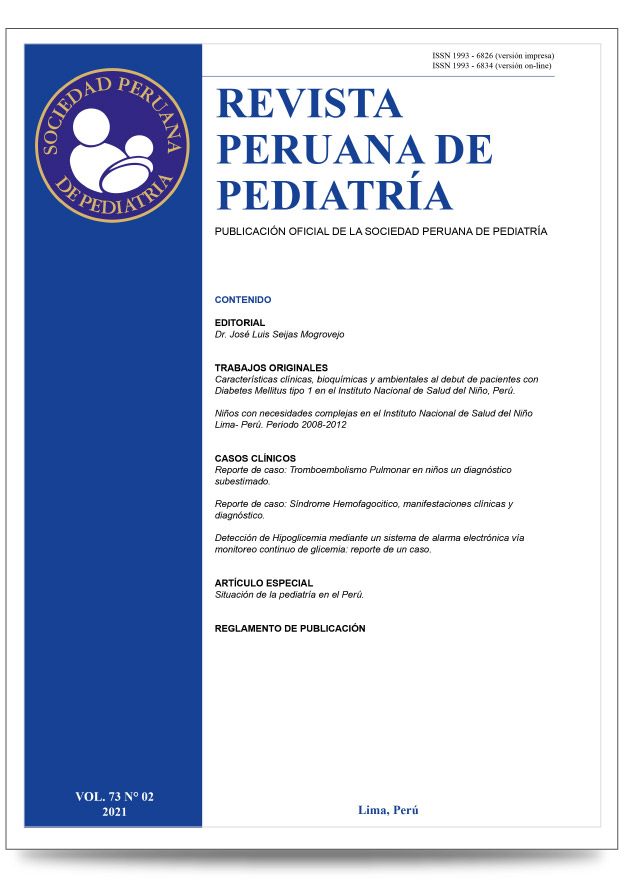Clinical, biochemical and environmental manifestations at the debut of Patients with type 1 Diabetes Mellitus at the Peruvian National Children’s Institute of Health
DOI:
https://doi.org/10.61651/rped.2021v73n2p09-15Keywords:
Diabetes Mellitus, Type 1, Incidence, Biomarkers, Child, Diabetic KetoacidosisAbstract
Objetivo: Determinar las características clínicas, bioquímicas y ambientales al debut de pacientes con diabetes mellitus tipo 1 (DM1) en el servicio de Endocrinología y Metabolismo (SEM) del Instituto Nacional de Salud del Niño (INSN), Perú.
Metodología: Es un estudio descriptivo, observacional y retrospectivo. Se revisaron 185 historias clínicas de pacientes con DM1 menores de 18 años, recibidos en el SEM del INSN entre enero del 2011 y diciembre del 2018 y se analizaron los datos de 60 pacientes que cumplieron con los criterios de inclusión.
Resultados: Se observó un aumento progresivo de casos nuevos por año, de 3 en el 2011 a 14 en el 2018, el 51.7% durante los meses de otoño e invierno. La edad promedio fue de 8.37 ± 3.69 años (15% menores de 5), 40 (66.7%) del sexo femenino y 35 (58.4%) con antecedentes familiares de DM. El 25% se presentó con cetoacidosis (CAD). La glucemia promedio fue de 316 ± 82.93mg/dl y la hemoglobina glicosilada, 10.87 ± 2.33%. Doce pacientes (28.5%) tuvieron enfermedad tiroidea autoinmune, siete con hipotiroidismo (5 subclínicos), uno con hipertiroidismo subclínico y cuatro eutiroideos. Sólo ocho (13.3%) presentaron anticuerpos antipancreáticos.
Conclusiones: Existe un incremento de la incidencia de DM1 en el INSN. El 81.7% debuta entre los 5 y 14 años de edad, con discreta mayoría femenina. Predomina la sintomatología clásica y solo el 25% debutó con CAD. Se requiere ampliar el registro de esta patología a nivel nacional, con énfasis en los aspectos genéticos y ambientales que contribuyan al conocimiento de su etiopatogenia.
Downloads
Downloads
Published
How to Cite
Issue
Section
Categories
License

This work is licensed under a Creative Commons Attribution 4.0 International License.
Authors will retain the copyright and grant the right to publish their work in the journal while allowing third parties to share it under the Creative Commons Attribution license.
Articles are published under a Creative Commons license that allows sharing and adaptation with appropriate credit. CC BY 4.0 license. Available in English at https://creativecommons.org/licenses/by/4.0/
Authors may use other information disclosure formats as long as the initial publication in the journal is cited. The dissemination of the work through the Internet is recommended to increase citations and promote academic exchanges.
The published content does not necessarily reflect the specific point of view of the journal, and the authors assume full responsibility for the content of their article.




